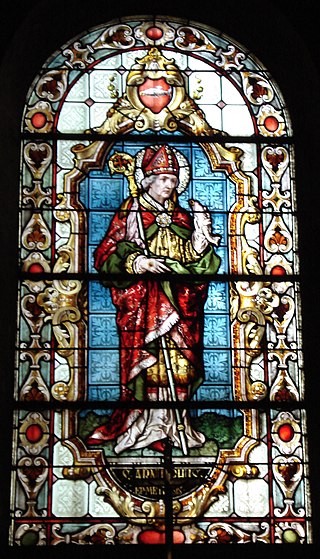
Pepin Iof Landen, also called the Elder or the Old, was the Mayor of the palace of Austrasia under the Merovingian King Dagobert I from 623 to 629. He was also the Mayor for Sigebert III from 639 until his death.

Pepin II, commonly known as Pepin of Herstal, was a Frankish statesman and military leader who de facto ruled Francia as the Mayor of the Palace from 680 until his death. He took the title Duke and Prince of the Franks upon his conquest of all the Frankish realms.

Nivelles is a city and municipality of Wallonia located in the Belgian province of Walloon Brabant. The Nivelles municipality includes the former municipalities of Baulers, Bornival, Thines, and Monstreux.

Andenne is a city and municipality of Wallonia located in the province of Namur, Belgium.

Arnulf of Metz was a Frankish bishop of Metz and advisor to the Merovingian court of Austrasia. He later retired to the Abbey of Remiremont. In French he is also known as Arnoul or Arnoulf. In English he is known as Arnold.

Amandus, commonly called Saint Amand, was a bishop of Tongeren-Maastricht and one of the catholic missionaries of Flanders. He is venerated as a saint, particularly in France and Belgium.

Gertrude of Nivelles, OSB was a seventh-century abbess who, with her mother Itta, founded the Abbey of Nivelles, now in Belgium.

A beguinage, from the French term béguinage, is an architectural complex which was created to house beguines: lay religious women who lived in community without taking vows or retiring from the world.

The Beguines and the Beghards were Christian lay religious orders that were active in Western Europe, particularly in the Low Countries, in the 13th–16th centuries. Their members lived in semi-monastic communities but did not take formal religious vows; although they promised not to marry "as long as they lived as Beguines", to quote an early Rule of Life, they were free to leave at any time. Beguines were part of a larger spiritual revival movement of the 13th century that stressed imitation of Jesus' life through voluntary poverty, care of the poor and sick, and religious devotion.

Saint Chlodulf was bishop of Metz approximately from 657 to 697.

Ultan was an Irish monk who later became an abbot. He was the brother of Saints Fursey and Foillan. He was a member of Fursey's mission from Ireland to East Anglia in c. 633, and lived there both as a monastic probationary and later alone as an anchorite. In c. 651 he accompanied his brother Foillan to Nivelles in Merovingian Gaul where they continued their monastic life together.

February 20 - Eastern Orthodox liturgical calendar - February 22

The Duchy of Brabant, a state of the Holy Roman Empire, was established in 1183. It developed from the Landgraviate of Brabant of 1085–1183, and formed the heart of the historic Low Countries. The Duchy comprised part of the Burgundian Netherlands from 1430 and of the Habsburg Netherlands from 1482, until it was partitioned after the Dutch revolt of 1566–1648.
Itta of Metz, O.S.B. was the wife of Pepin of Landen, Mayor of the Palace of the Kingdom of Austrasia. After his death, she founded the Abbey of Nivelles, where she became a Colombanian nun along with her daughter, Gertrude of Nivelles. Both are honored as saints by the Catholic Church.

Saint Foillan is an Irish saint of the seventh century.

December 16 - Eastern Orthodox liturgical calendar - December 18

The Collegiate Church of St. Gertrude is a Roman Catholic collegiate church in Nivelles, Walloon Brabant, Belgium, which was built in the 11th century. It is dedicated to Saint Gertude, the patron saint of cats.

The Church of St. John the Baptist at the Béguinage is a Catholic parish church in central Brussels, Belgium. It is dedicated to Saint John the Baptist.

Nivelles Abbey is a former Imperial Abbey of the Holy Roman Empire founded in 640. It is located in Nivelles, Walloon Brabant, Belgium.

The Collegiate Church of Saint Begga is a collegiate church in Andenne, Belgium. Founded in the 7th century, the currently visible church dates from 1770 to 1775 and was designed by architect Laurent-Benoît Dewez.

















